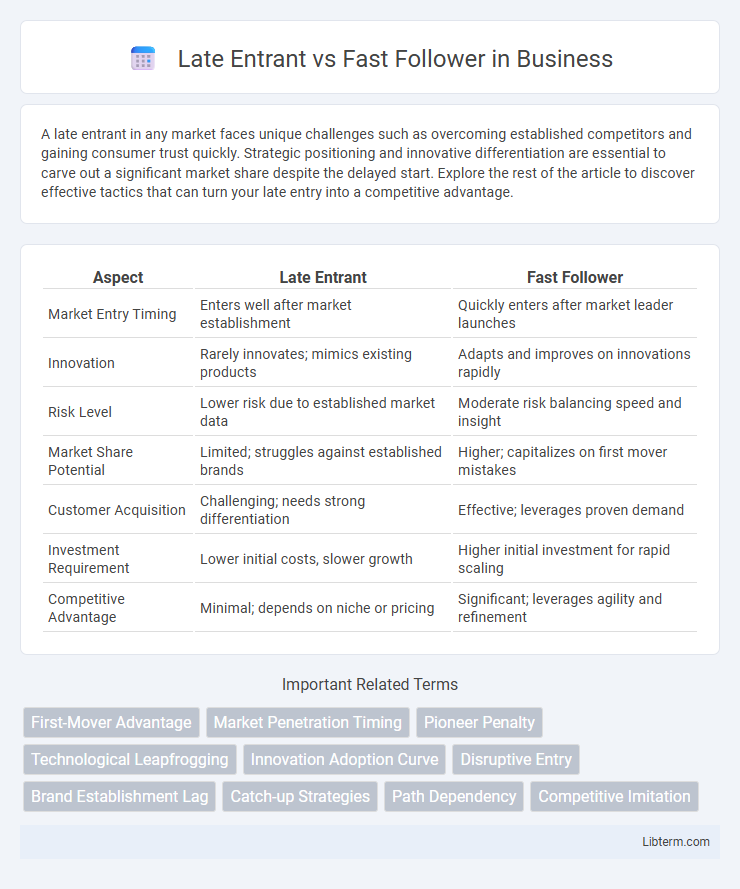A late entrant in any market faces unique challenges such as overcoming established competitors and gaining consumer trust quickly. Strategic positioning and innovative differentiation are essential to carve out a significant market share despite the delayed start. Explore the rest of the article to discover effective tactics that can turn your late entry into a competitive advantage.
Table of Comparison
| Aspect | Late Entrant | Fast Follower |
|---|---|---|
| Market Entry Timing | Enters well after market establishment | Quickly enters after market leader launches |
| Innovation | Rarely innovates; mimics existing products | Adapts and improves on innovations rapidly |
| Risk Level | Lower risk due to established market data | Moderate risk balancing speed and insight |
| Market Share Potential | Limited; struggles against established brands | Higher; capitalizes on first mover mistakes |
| Customer Acquisition | Challenging; needs strong differentiation | Effective; leverages proven demand |
| Investment Requirement | Lower initial costs, slower growth | Higher initial investment for rapid scaling |
| Competitive Advantage | Minimal; depends on niche or pricing | Significant; leverages agility and refinement |
Understanding Late Entrant and Fast Follower Strategies
Late entrant strategies involve companies entering a market well after pioneers have established the space, focusing on learning from early movers' successes and mistakes to reduce risks and optimize resource allocation. Fast followers rapidly adopt and improve upon innovations introduced by early entrants, leveraging market feedback to enhance product features and capture significant market share. Both strategies prioritize agility and market responsiveness over pioneering innovation, aiming to balance competitive advantage with minimized uncertainty.
Key Differences Between Late Entrants and Fast Followers
Late entrants enter the market well after the pioneers and fast followers, often facing higher barriers such as established brand loyalty and market saturation. Fast followers quickly replicate and improve upon innovations introduced by pioneers, benefiting from reduced research and development costs and lessons learned from early market feedback. The key difference lies in timing and strategy: fast followers leverage speed and agile adaptation to gain competitive advantage, while late entrants rely on differentiating factors to penetrate mature markets.
Advantages of Being a Late Entrant
Late entrants benefit from reduced risks by learning from the mistakes and successes of early market pioneers, enabling more informed strategic decisions. They can capitalize on established market infrastructure and consumer behavior patterns, reducing initial costs and accelerating market penetration. Access to advanced technology and enhanced product features often gives late entrants a competitive edge, allowing them to meet evolving customer demands more effectively.
Benefits of Adopting a Fast Follower Approach
Adopting a fast follower approach allows companies to reduce market entry risks by learning from the mistakes and successes of early entrants, accelerating product development and innovation cycles. Fast followers can leverage established market validation, enabling targeted marketing strategies and resource allocation that enhance competitive positioning. This strategy fosters agility, allowing rapid adaptation to consumer feedback and emerging trends while benefiting from improved technology and cost efficiencies.
Risks and Challenges for Late Entrants and Fast Followers
Late entrants face risks such as limited market share, higher customer acquisition costs, and difficulty differentiating from established competitors. Fast followers encounter challenges including the risk of being perceived as imitators, pressure to innovate quickly, and potential legal issues related to intellectual property. Both strategies demand careful market analysis and agile execution to overcome barriers and capitalize on emerging opportunities.
Market Entry Timing: Strategic Considerations
Late entrants leverage established market insights and customer feedback to refine products, reducing the risks and costs associated with pioneering innovation. Fast followers capitalize on rapid deployment and adaptation of emerging trends, striving to capture market share before competitors consolidate dominance. Both strategies require careful timing and resource allocation to balance speed against market certainty for optimal competitive advantage.
Case Studies: Success Stories of Late Entrants
Late entrants in the market leverage established industry knowledge and customer insights to outperform early movers, as demonstrated by Netflix's transformation from a DVD rental service to the dominant streaming giant, surpassing Blockbuster. Case studies reveal that late entrants like Apple in the smartphone market capitalized on existing technologies and consumer feedback to refine their iPhone, creating a superior product that overshadowed pioneers like Nokia and BlackBerry. These success stories underscore how strategic innovation, effective timing, and market adaptation enable late entrants to not only survive but also redefine industries.
Case Studies: Notable Fast Follower Examples
Fast followers like Facebook and Google serve as prime examples of companies that rapidly capitalized on early entrants' innovations, refining and scaling products for greater market success. Facebook leveraged MySpace's initial social networking groundwork to create a more user-friendly and feature-rich platform, ultimately dominating the industry. Google improved on early search engines such as Yahoo and AltaVista by delivering faster, more relevant search results, establishing itself as the global leader in online search.
Choosing the Right Strategy for Your Business
Late entrants risk high market entry costs but benefit from learning from pioneers' mistakes, whereas fast followers capitalize on rapid innovation and improved product iterations to capture market share efficiently. Businesses must analyze competitive intensity, innovation speed, and consumer readiness to determine which approach maximizes ROI and market impact. Selecting the right strategy hinges on assessing internal capabilities, resource availability, and the dynamics of the target industry.
Future Trends in Market Entry and Competitive Positioning
Late entrants leverage advanced market insights and emerging technologies to strategically position themselves with reduced risk and lower initial costs, enabling agile responses to evolving consumer demands. Fast followers capitalize on the pioneering innovations of early entrants by quickly adapting successful products and scaling operations efficiently, often gaining a competitive edge through improved supply chains and enhanced customer experiences. Future trends emphasize hybrid strategies combining predictive analytics, AI-driven market intelligence, and sustainable innovation to optimize timing and competitive positioning in dynamic global markets.
Late Entrant Infographic

 libterm.com
libterm.com